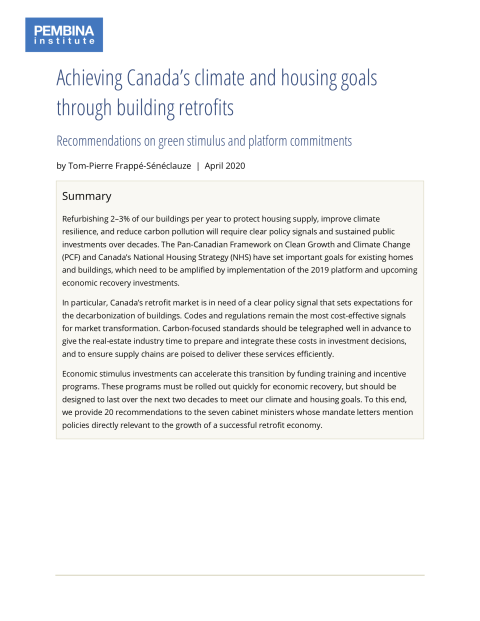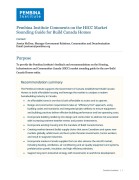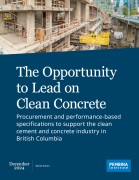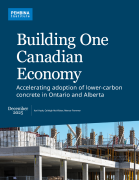The Pembina Institute sent the following letter and recommendations to the Government of Canada:
April 29, 2020
Hon. Seamus O’Regan
Minister of Natural Resources
House of Commons
Ottawa, ON K1A 0A6
Hon. Jonathan Wilkinson
Minister of Environment and Climate Change
House of Commons
Ottawa, ON K1A 0A6
Hon. Catherine McKenna
Minister of Infrastructure and Communities
House of Commons
Ottawa, ON K1A 0A6
Dear Ministers:
Re: Green stimulus in Canada’s building sector
With the COVID-19 pandemic at the forefront of our minds, we want to underscore the primary need to protect Canadians’ health and livelihoods, and applaud the swift and ongoing response from all levels of government to keep Canadians safe. We see this as a moment of paramount importance for ensuring the health of Canadians and future resilience of our economy. Investments made today will define our well-being, competitiveness, and economic strength in a decarbonizing global market.
Green stimulus investments, paired with clear policy signals, can play a transformative role in the implementation of the Pan-Canadian Framework on Clean Growth and Climate Change (PCF), Canada’s National Housing Strategy (NHS), and several of the policies and programs outlined in your ministerial mandate letters. The renovation of existing homes and buildings is a multi-year megaproject that can create economic activity in all regions of Canada while addressing housing and climate objectives. While the PCF and NHS provide first steps towards decarbonization of the building sector and ensuring a roof for all, they do not yet have the regulatory clarity and fiscal firepower to achieve these goals.
To eliminate carbon pollution from Canada’s homes and buildings by 2050, we must refurbish 2–3% of stock per year; each building we touch must be put on a zero-carbon plan, and be better prepared for extreme weather events. This is not a small endeavour: It will require an investment on the order of $10–15 billion per year over the next 30 years, leveraging both public and private capital. Upgrading these buildings will require close co-ordination between regulations and incentive programs, informed by transparent building data.
The intention to regulate carbon pollution from new and existing buildings must be made clear to the construction and real estate industries to give them time to prepare. More than three years after the signing of the PCF, most provinces and territories (P/T) have not signalled their intention to adopt net-zero energy building codes and none have a comprehensive roadmap for decarbonizing the building sector by mid-century. To address the climate emergency, codes and regulations cannot focus only on energy efficiency; they must also address fuel choice and set clear, decreasing carbon pollution limits for new and existing buildings.
Public subsidies are needed to build capacity ahead of regulations and to minimize impacts on housing affordability. To be effective, incentive programs must prioritize deep retrofits over incremental gains and be built to last until backstopped by regulations; the boom and bust resulting from short-lived incentive programs is detrimental to the establishment of a mature retrofit industry.
To guide investments and ongoing refinement of incentives and regulations, government and industry need transparent building data on assets and performance. Access to usable, validated building information is also necessary for the real estate and insurance industries to assess climate and regulatory risks and to assign value to building retrofits.
Key recommendations:
- Set explicit carbon pollution limits in building codes for new and existing buildings and adopt federal heating equipment standards requiring low-carbon systems by 2030.
- Work with P/T to develop carbon reduction targets for the building sector for 2030, 2040, and 2050.
- Make a major nationwide infrastructure investment in retrofits for existing buildings by increasing the Greener Home retrofit target and expanding it to include multi-unit residential buildings, using grants and loans to cover a significant portion of the retrofit cost.
- Co-finance deep retrofits of public and commercial buildings with a focus on schools, hospitals, and social housing.
- Invest $500 million for training for Canada’s low-carbon building workforce.
- Make access to a portion of these funds conditional on advancing regulatory roadmaps for a zero-carbon building sector by 2050.
- Focus incentives and programs on deep retrofits and fuel switching; incentives should not be provided for natural gas furnaces or boilers unless long-term contracts for renewable gas can be secured.
- Develop a comprehensive national building data framework, including open data policies for public agencies (improve data standards and provide open access to data stored at local, provincial, and federal levels), electronic data transfer requirements for utility data, and implementation of energy performance disclosure policies.
These recommendations are further detailed in the enclosed document. Given the number of departments and agencies involved, we recommend the creation of a cross-ministerial working group to co-ordinate a national retrofit strategy, supported by an expert advisory panel. We would be happy to meet via videoconference to discuss these recommendations with you or your staff.
Yours sincerely,
Linda Coady
Executive Director
Pembina Institute
Enclosure: Achieving Canada’s climate and housing goals through building retrofits
cc:
Hon. Bill Morneau — Minister of Finance
Tyler Meredith — Director of Policy, Office of the Minister of Finance
Matthew Whittington — Director of Policy, Office of the Minister of Natural Resources
Erin Flanagan — Director of Climate, Energy and Regulatory Affairs, Office of the Minister of Environment and Climate Change
Claire Seaborn — Director of Policy and Legal Affairs, Office of the Minister of Infrastructure and Communities
Abdikheir Ahmed — Director of Policy, Office of the Minister of Family, Children and Social Development
Full list of recommendations
For details, see the enclosed document, Achieving Canada’s climate and housing goals through building retrofits.
Retrofits in homes (Green Homes program)
Minister of Natural Resources Seamus O’Regan
Minister of Families, Children and Social Development Ahmed Hussen
1. Increase the Greener Home retrofit target and pair loans with outcome-based grants
2. Partner with retail banks and financial technology firms for program delivery.
3. Align with residential PACE (Property-Assessed Clean Energy) programming.
4. Allow the formula to vary by market segment, region, and equity considerations.
5. Develop low-cost labelling tools aligned with EnerGuide, and work with provinces and territories to implement labelling requirements at point of sale or rental.
6. Create an ongoing funding mechanism for low-carbon finance programs distinct from general revenues.
Retrofits in affordable housing
Minister of Families, Children and Social Development Ahmed Hussen
Minister of Infrastructure and Communities Catherine McKenna
7. Create a top-up fund for NHS-funded retrofits and new construction projects that achieve deep carbon reductions.
8. Require stronger climate resiliency in NHS-funded projects.
9. Provide more flexibility on meeting accessibility targets in retrofit situations.
10. Create a market-rental preservation program.
Retrofits in commercial buildings
Minister of Natural Resources Seamus O’Regan
Minister of Infrastructure and Communities Catherine McKenna
Minister of Finance Bill Morneau
11. Develop an arm of the Canada Infrastructure Bank dedicated to the identification, underwriting, and securitization of commercial retrofit loans.
12. Collaborate with the Canada Mortgage and Housing Corporation and the Federation of Canadian Municipalities on the development of a national commercial PACE program.
13. Launch a loan guarantee program for high-performance retrofit projects.
Integration with Pan-Canadian Framework commitments and other policies
Minister of Environment and Climate Change Jonathan Wilkinson
Minister of Natural Resources Seamus O’Regan
Minister of Families, Children and Social Development Ahmed Hussen
Minister of Employment, Workforce Development and Disability Inclusion Carla Qualtrough
Minister of Infrastructure and Communities Catherine McKenna
Minister of Innovation, Science and Economic Development Navdeep Bains
Minister of Finance Bill Morneau
14. Invest $500 million in workforce development and training.
15. Make access to a portion of funds for incentives and capacity building conditional on advancing regulatory roadmaps for a zero-carbon building sector by 2050.
16. Add an explicit climate objective in codes.
17. Adopt high-performance regulations sooner.
18. Facilitate access to building data by citizens, governments, and companies.
19. Include low-carbon heating equipment, grid-interactive building components, and other high-performance building components when defining zero-emission technologies eligible for tax cuts.
20. Form a cross-ministerial working group for the co-ordination of a retrofit building strategy.









